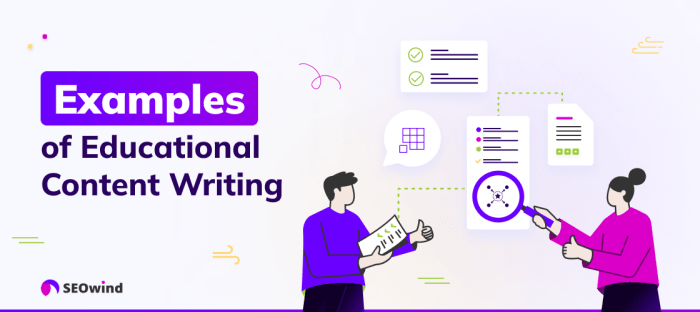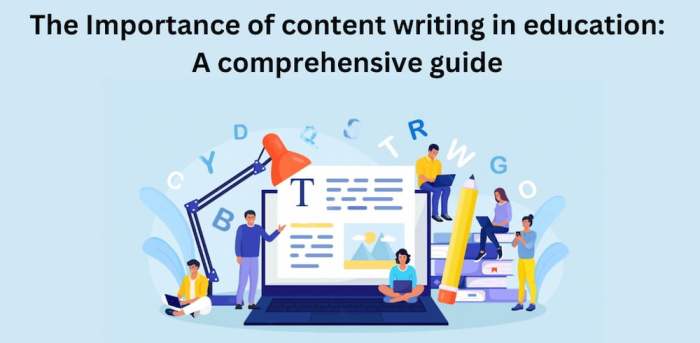Writing Educational Content sets the stage for creating captivating material that not only educates but also enthralls the audience, making learning a dynamic and enriching experience.
Exploring the diverse formats and strategies involved in crafting compelling educational content opens up a world of possibilities for content creators seeking to make a lasting impact.
Importance of Writing Educational Content

Creating educational content for online platforms is crucial in today’s digital age. It allows individuals to access valuable information and knowledge from anywhere at any time. Well-written educational content not only engages readers but also effectively educates them on various topics, helping them expand their understanding and skills.
Engaging and Educating Readers
When educational content is well-crafted, it has the power to captivate the audience and deliver information in a clear and concise manner. By using engaging language, visuals, and interactive elements, content creators can effectively convey complex concepts and make learning an enjoyable experience for readers.
- Successful Educational Content Examples:
“The Khan Academy” offers free educational videos and exercises on a wide range of subjects, making learning accessible to all.
“TED-Ed” produces animated videos that simplify complex topics and engage viewers through storytelling and visuals.
“Crash Course” provides educational videos on various subjects, presented in a fun and entertaining way to keep viewers interested and informed.
Types of Educational Content
When it comes to creating educational content, there are various formats to choose from. Each format has its own strengths and weaknesses, making it important to select the right one based on the target audience and subject matter.
Articles
Articles are a common form of educational content that allows for in-depth exploration of a topic. They are great for presenting detailed information, analysis, and arguments in a structured manner. Articles are text-based and can be easily accessed and shared online. However, they may not be as engaging as other formats and require strong writing skills to maintain reader interest.
Videos
Videos are a popular choice for educational content due to their visual appeal and ability to convey complex information in a concise and engaging way. They are effective in capturing the audience’s attention and can incorporate visual aids, animations, and demonstrations to enhance learning. However, creating high-quality videos can be time-consuming and may require technical expertise.
Infographics
Infographics are graphic visual representations of information, data, or knowledge intended to present complex information quickly and clearly. They are great for simplifying complex concepts and making data more digestible. Infographics are highly shareable on social media platforms and can attract a wider audience. However, they may not be suitable for topics that require a more detailed explanation.
Podcasts, Writing Educational Content
Podcasts are audio recordings that can be accessed on-demand and are a convenient way for people to consume educational content while on the go. They are great for storytelling, interviews, discussions, and delivering information in a conversational tone. Podcasts are versatile and can cater to different learning styles. However, they may require good editing skills and engaging hosts to keep listeners interested.Choosing the right format for your educational content depends on factors such as the target audience’s preferences, the complexity of the subject matter, and the resources available for content creation.
It’s important to consider the strengths and limitations of each format to effectively deliver educational information to your audience.
Strategies for Creating Engaging Educational Content: Writing Educational Content

When it comes to developing compelling educational content, there are several key steps that can help in capturing the attention of students and making learning more enjoyable. One effective strategy is to incorporate storytelling techniques to make the content more engaging and relatable. By weaving narratives into the educational material, students are more likely to connect with the information on a deeper level.
Incorporating Storytelling Techniques
- Use real-life examples and scenarios to illustrate key concepts.
- Develop characters that students can relate to and follow throughout the content.
- Create a narrative arc that guides students through the learning journey.
Storytelling can bring educational content to life, making it more memorable and impactful. Here are some ways to incorporate storytelling techniques:
Importance of Visuals, Examples, and Interactive Elements
- Visuals: Images, infographics, and videos can help clarify complex topics and make the content more visually appealing.
- Examples: Providing real-world examples helps students understand how to apply theoretical knowledge in practical situations.
- Interactive Elements: Quizzes, games, and interactive exercises encourage active participation and reinforce learning outcomes.
Visuals, examples, and interactive elements play a crucial role in enhancing educational content and keeping students engaged. Here’s why they are important:
Best Practices in Writing Educational Content
When it comes to creating educational content, structuring it in a way that enhances readability is crucial. By following certain guidelines, such as using headings, subheadings, and bullet points effectively, you can organize information in a clear and engaging manner.
Guidelines for Structuring Educational Content
To improve readability, it is essential to utilize headings, subheadings, and bullet points to break down information into easily digestible chunks. Headings and subheadings provide a roadmap for readers, guiding them through the content. Bullet points help highlight key points and make the text more scannable.
Importance of Clarity, Accuracy, and Credibility
In educational content, clarity is paramount to ensure that information is easily understood by the audience. Accuracy is crucial to avoid misinformation and provide reliable knowledge. Credibility is established through proper research and citing reputable sources, which enhances the trustworthiness of the content.
